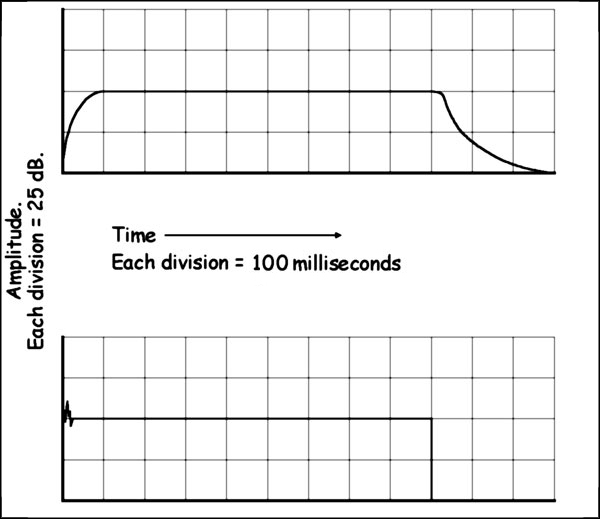The HAMMOND ORGAN
North Suburban HAMMOND ORGAN Service
The next items that we should investigate regarding traditional Hammond organs are the speaker cabinets and power amplifiers, for it is here where the electrical signals generated in the console finally become audible sound.
Before looking at these, it might be good to digress slightly and look at envelopes. In this case, we're not talking about something you put letters in and take to the post office. An envelope when referring to a musical tone relates to some aspect of the way it develops, progresses and ceases. The envelope which we are most concerned with is the volume envelope which considers a particular tone from the moment you push a key until you let go of the key and the sound has ceased.

Envelope graphs
In most natural (non-electronic) instruments, tones never begin entirely instantaneously. They may begin very quickly, sometimes in the case of percussion instruments reaching full volume in less than a millisecond, but they are never instantly at full power. Likewise when they stop, they stop gradually. Some tones cease almost immediately, and some such as bells may ring off over a period of several seconds. However, no tone from any natural musical instrument is ever instantly on at full power and no such tone is ever immediately silent when it is supposed to stop.
The Hammond organs, however, have this instant-on, instant-off characteristic and, although it might not at first seem important, it is actually very important. Below are two illustrations showing the volume envelope of a typical organ pipe, and the volume envelope of a typical note on a Hammond organ. The total time represented in each graph is 1.2 seconds.
The top graph shows the volume envelope for a typical organ pipe. Notice that the volume gradually rises to its steady-state level, and then at the right end of the graph, when we let go of the key, its volume drops off gradually. The start of the tone is called the attack, and then ending is called the decay. Although in casual listening the attack and decay of the organ pipe will seem essentially instantaneous, they are not; and this subtle difference significantly enhances the tone. This is especially true when we play a melody and one note follows another. These subtle, gradual attacks and decays make subsequent notes of a melody follow each other and add a "singing" quality to the overall perceived sound.
Now let's contrast that with the volume envelope of a typical Hammond which we see in the lower graph. We push a key, the switch contacts close under the key, and the tone is instantly on. Because we are closing switch contacts and turning on an existing electrical signal, right at the onset there will be a small random burst of high frequencies which we show at the left of the lower graph as the small jagged line. In this particular instance, the small jagged line part of this graph is an actual look at the waveshape. I included that to show you what a Hammond key click looks like graphically. The rest of this graph represents the volume envelope. This jagged line sounds like a small pop or click. Indeed, this is the famous Hammond key click, a phenomenon that is very unnatural.
Likewise at the end of the tone, we let go of a key and once the contacts are open, the tone is off. There's no gradual fade out. Laurens Hammond was not a musician, however he had people on his payroll who were, and they very early on found out that they had to do something about this, otherwise the Hammond might not sound as good as it should, especially in a small room such as the typical living rooms in the homes where many Hammonds went.
Previous page Page 15. Next page